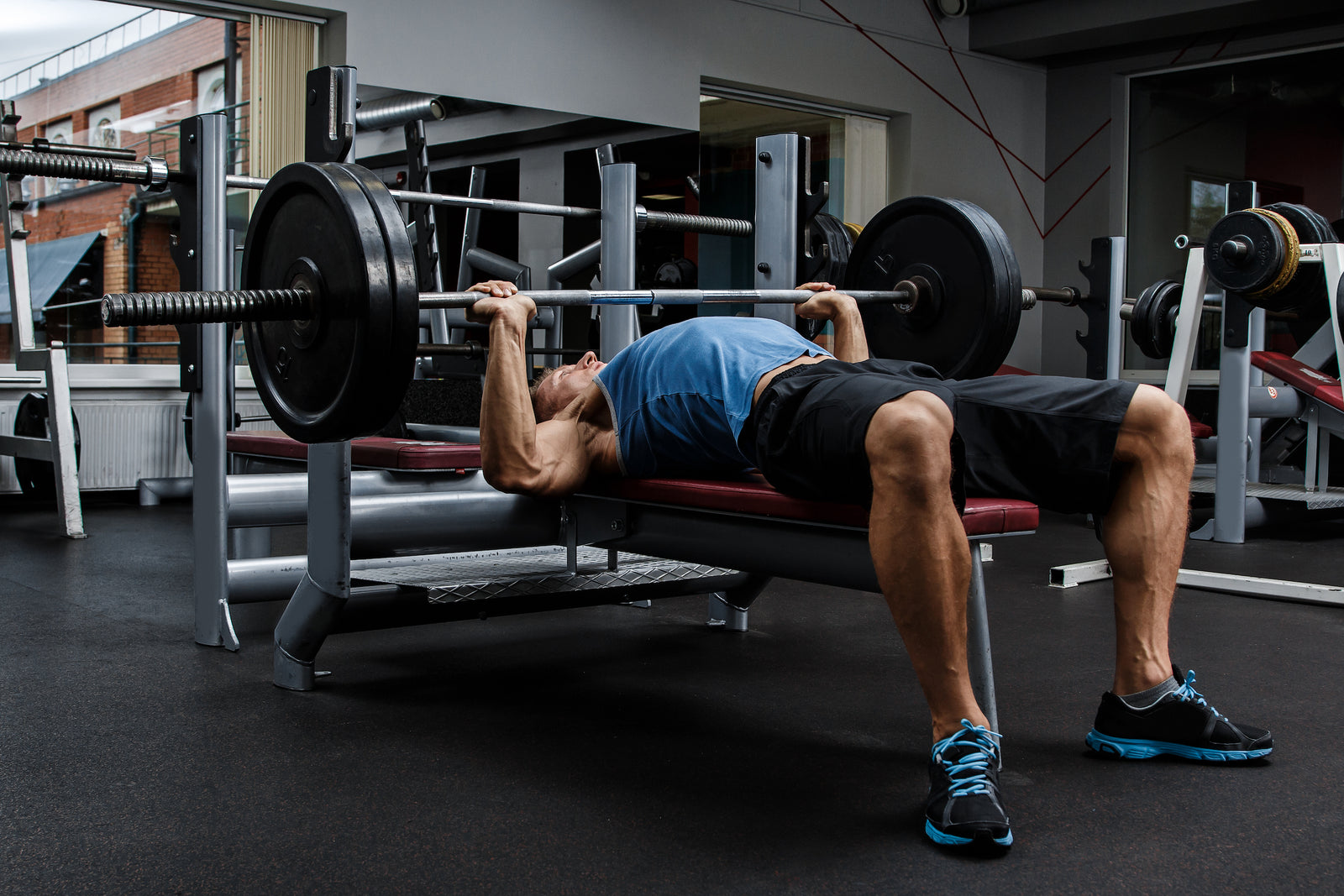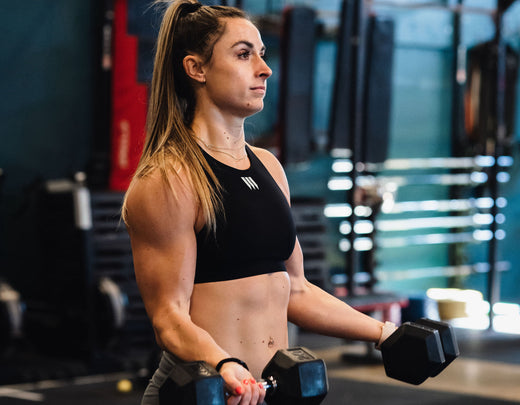Incline and flat bench are two of the most common compound strength movements, proven to build more functional strength. Both are powerful exercises that activate several muscle groups, including the pectoralis, triceps, shoulders, back and core. Including the incline and flat bench in your functional training or split programming, will help you build more muscle and perform at a higher level.
Incline Bench Press
The incline bench press is a compound movement and works multiple muscle groups such as the pectoralis major, anterior deltoids, and your triceps. Setting the bench at a 15-30% incline will activate your shoulders and place less stress on your rotator cuff, which is a common area for injury during flat bench press.
Like most exercises there are several variations of the incline bench press. Wider and narrower grip positioning will also target different parts of your chest to ensure a well-rounded aesthetic, more strength, and improved posture.
Some incline bench variations include
- Incline Dumbbell Bench Press
- Smith Machine Incline Bench Press
- Incline Dumbbell Bench Press with Bosu Ball
Bench Press
Bench press is a compound movement that involves the pectoralis major, deltoids, triceps, and the upper arms. The bench press can develop and build more strength and size, and also improve balance in movements amongst athletes.
Several variations of the bench press exist, which incorporate different segments and angels of the pectoralis major to ensure well rounded aesthetic, strength, and posture as well as training implements.
Some of those variations include
- Dumbbell Bench Press
- Incline Bench Press
- Incline Dumbbell Bench Press
- Decline Bench Press
- Decline Dumbbell Bench Press
- Smith Machine Bench Press
5 Proven Benefits Of Incline And Flat Bench
1. Bench Press Builds More Strength
Incline and flat bench are considered compound movements. A compound exercise uses multiple muscle groups and joints at the same time, compared with an isometric exercise which involves the static contraction of a muscle without any visible movement in the angle of the joint. Both incline and flat bench primarily work the pectoralis major, with secondary muscles which involve the shoulders, triceps, biceps and shoulder joints.
Research has shown that dependent upon the specific variations and angle of the bench press (i.e., dumbbell bench press, smith machine bench and barbell bench), each one activates the pectoralis to a different degree. For example, a study published in the Journal Of Strength and Conditioning showed that the dumbbell flat bench press elicited greater changes in pectoralis major activity as compared to barbell bench press [R]. The study also concluded that study participants were able to achieve higher volume, or more repetitions as compared to barbell bench press, which also increased activation. Barbell bench however shows greater muscle activation in the pectoralis, and medial deltoid also known as your shoulders, than the smith machine, indicating that barbell bench is a better choice for upper-body muscle development. With increased workout volume and better muscle activation, you’ll be able to increase overall muscle strength [R].
2. Bench Press Increases Muscle Mass
Resistance training programs which include strength-training movements such as incline and flat bench, will also increase muscle growth and mass. Training programs, which emphasize volume, and higher repetitions, at 60-80% maximal load, will help build more lean mass as opposed to lower volume, with increased loads.
RELATED ARTICLE How Many Sets And Reps Do I Need To Improve Performance
3. Bench Press Corrects Muscular Imbalances
Bench press is considered a functional strength movement. Function means purpose; therefore, a functional movement is performed for a specific purpose. That purpose is to build more strength, balance, and stability recruited to execute common movement patterns while performing everyday activities. Muscular imbalances are an issue which is highly prevalent and common amongst many people.
According to the National Association of Sports Medicine (NASM), muscular imbalance is the alteration in the lengths and relative activity levels of muscles surrounding a given joint. With some of these muscles being short and/or overactive and others being lengthened and/or underactive, movement compensation occurs and consequently decreases neuromuscular control. Therefore, when a muscular imbalance is severe enough, compensation for lack of mobility of those muscles will occur. Bench press either barbell, or with dumbbells uses free weights, which requires more muscle stabilization and greater core strength, to help overcome and correct muscular imbalances over time.
RELATED ARTICLE How To Fix Muscular Imbalances In 5 Easy Steps
4. Bench Press Increases Bone Density
Resistance training has been shown to improve bone density and aid in supporting bone health. Studies show that functional compound movements, such as squat, deadlift, and bench press can significantly increase bone density [R]. As we age, bone’s become frail and porous, causing chronic disease states such as Osteoporosis. By engaging in resistance training programs and including compound movements such as the bench press, you can improve bone health, which translates to greater improvements in overall quality of life.
5. Bench Press Will Burn More Body Fat
It’s a proven fact that the more muscle mass you have, the more calories you burn at rest. Strength training and exercise movements such as the incline and flat bench will help build more muscle mass, therefore burning more calories at rest, boosting your metabolic rate. Resting muscle tissue burns 6kcal/lb per day at rest, thus the more muscle you have, the more calories you burn.
When you work out and lift weights, your metabolism stays elevated through a process called excess post-exercise oxygen consumption (EPOC). Commonly referred to as the after-burn effect, EPOC refers to the oxygen and energy (in calories) it takes for your body to repair your muscle tissue during recovery. EPOC can be a major contributor to your total daily caloric expenditure by increasing your body’s thermic effect [R]. Prolonged workouts with more intense resistance training at heavier weights have been associated with a more substantial EPOC [R].
RELATED ARTICLE What Is Thermogenesis
Incline Vs Flat Bench
The bench press is one of the founding exercises in strength training, considered as part of the “Big 3” for building power and strength, along with the squat and deadlift. Competitive athletes can greatly benefit from incorporating both the incline and flat bench into their training protocol which can contribute significant power and strength to improve performance.
The incline bench follows the same movement pattern as the flat bench, just with a variation in bench position. Incline bench is normally set at a 30-45-degree angle, to target the upper chest. The higher the angle of the incline, the more emphasis that will be put on the anterior (front) deltoids. Therefore, keeping it to a 30-degree angle will ensure, you are targeting the upper chest, without so much on the shoulders.
Electromyographic studies (EMG) which records muscle activation during strength training movements, has shown some differences between incline vs flat bench, in specific muscle activation. For example, incline bench places increased activation on the clavicular portion of the pecs, with reduced activation of the sternocostal fibers. It also recruits 58.5-62.6% lower triceps brachii activation, but 48.3-68.7% greater biceps brachii activation in the inclined bench compared with the flat bench [R].
Incline Vs Flat Bench: Differences & Similarities In Summary
- The pectoralis is comprised of a clavicular and a sternocostal head (upper and lower pec). The main purpose of the incline bench is to focus on the upper pecs and develop that portion of the muscle. The flat bench builds more muscle mass over the entire area of the pec, as opposed to a segmented portion.
- Both flat bench and incline put emphasis on the triceps, shoulders, and pectoralis helping build more muscle mass and strength.
- Incline places less stress on your rotator cuff which is a common area for injury while performing the flat bench
- Incline bench places more emphasis on the anterior deltoid, improving muscle growth and strength in the shoulders.
Need Help With Optimizing Your Nutrition and Training Plan To Finally Get The Results You've Been Waiting For?
SWOLVERINE IS AN ENDURANCE ATHLETE AND ACTIVE LIFESTYLE BRAND. MADE FOR THE ELITE ATHLETE, AND THE STRONG-WILLED OUR PRODUCTS WERE DESIGNED TO FUEL YOUR ATHLETIC PERFORMANCE. WE PERFORM WHEN YOU PERFORM.
We believe that everyone can optimize not only their athletic performance but their human potential. The way we believe we can optimize performance is through transparency, clinically effective doses, and clinically proven ingredients with evidence-based outcomes. We provide the nutrients you need to power your active lifestyle.








